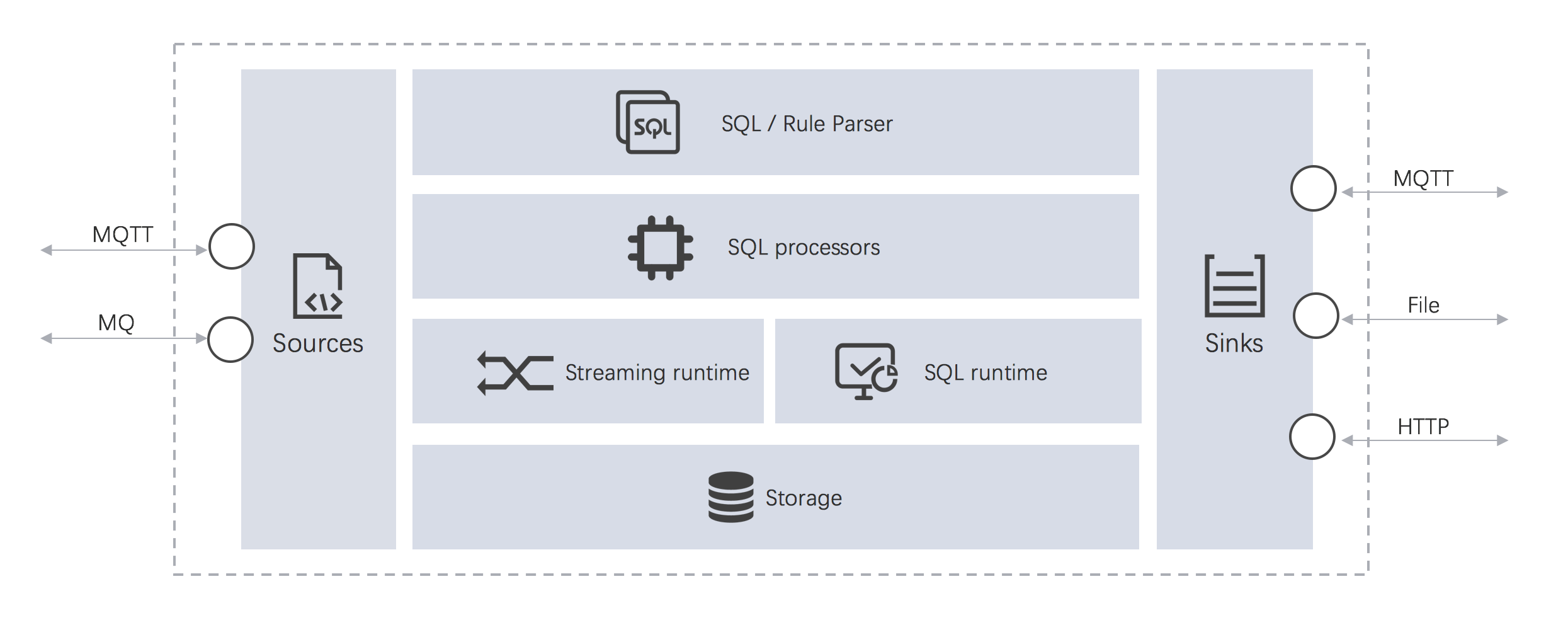Welcome to the eKuiper Wiki
LOGO
Overview
eKuiper is an edge lightweight IoT data analytics / streaming software implemented by Golang, and it can be run at all kinds of resource constrained edge devices. One goal of eKuiper is to migrate the cloud streaming software frameworks (such as Apache Spark,Apache Storm and Apache Flink) to edge side. eKuiper references these cloud streaming frameworks, and also considered special requirement of edge analytics, and introduced rule engine, which is based on Source, SQL (business logic) and Sink, rule engine is used for developing streaming applications at edge side.
User scenarios
It can be run at various IoT edge use scenarios, such as real-time processing of production line data in the IIoT; Gateway of Connected Vehicle analyze the data from data-bus in real time; Real-time analysis of urban facility data in smart city scenarios. eKuiper processing at the edge can reduce system response latency, save network bandwidth and storage costs, and improve system security.
Features
Lightweight
- Core server package is only about 4.5M, initial memory footprint is about 10MB
Cross-platform
- CPU Arch:X86 AMD * 32, X86 AMD * 64; ARM * 32, ARM * 64; PPC
- The popular Linux distributions, OpenWrt Linux, MacOS and Docker
- Industrial PC, Raspberry Pi, industrial gateway, home gateway, MEC edge cloud server
Data analysis support
- Support data extract, transform and filter through SQL
- Data order, group, aggregation and join
- 60+ functions, includes mathematical, string, aggregate and hash etc
- 4 time windows & count window
Highly extensibile
Plugin system is provided, and it supports to extend at
Source,SQL functionsandSink.- Source: embedded support for MQTT, and provide extension points for sources
- Sink: embedded support for MQTT and HTTP, and provide extension points for sinks
- UDF functions: embedded support for 60+ functions, and provide extension points for SQL functions
Management
- A web based management dashboard for nodes, plugins, streams & rules management
- Plugins, streams and rules management through CLI & REST API
- Easily be integrate with KubeEdge, K3s and Baetyl, which bases Kubernetes
Integration with EMQ X Edge
Seamless integration with EMQ X Neuron & EMQ X Edge, and provided an end to end solution from messaging to analytics.
Quick Start
Performance Test Result
MQTT throughput test
- Using JMeter MQTT plugin to send simulation data to EMQ X Broker, such as:
{"temperature": 10, "humidity" : 90}, the value of temperature and humidity are random integer between 0 - 100. - eKuiper subscribe from EMQ X Broker, and analyze data with SQL:
SELECT * FROM demo WHERE temperature > 50 - The analysis result are wrote to local file by using file sink plugin.
| Devices | Message # per second | CPU usage | Memory usage |
|---|---|---|---|
| Raspberry Pi 3B+ | 12k | sys+user: 70% | 20M |
| AWS t2.micro( 1 Core * 1 GB) Ubuntu18.04 | 10k | sys+user: 25% | 20M |
EdgeX throughput test
A Go application is wrote to send data to ZeroMQ message bus, the data is as following.
{ "Device": "demo", "Created": 000, … "readings": [ {"Name": "Temperature", value: "30", "Created":123 …}, {"Name": "Humidity", value: "20", "Created":456 …} ] }eKuiper subscribe from EdgeX ZeroMQ message bus, and analyze data with SQL:
SELECT * FROM demo WHERE temperature > 50. 90% of data will be filtered by the rule.The analysis result are sent to nop sink, all of the result data will be ignored.
| Message # per second | CPU usage | Memory usage | |
|---|---|---|---|
| AWS t2.micro( 1 Core * 1 GB) Ubuntu18.04 | 11.4 k | sys+user: 75% | 32M |
Max number of rules support
- 8000 rules with 800 message/second
- Configurations
- 2 core * 4GB memory in AWS
- Ubuntu
- Resource usage
- Memory: 89% ~ 72%
- CPU: 25%
- 400KB - 500KB / rule
- Rule
- Source: MQTT
- SQL: SELECT temperature FROM source WHERE temperature > 20 (90% data are filtered)
- Sink: Log
Help Us Improve the Wiki
This Wiki is owned by the Secure Device Onboard Community. Contributions are always welcomed to help make it better!
In upper right, select Log In. You will need a Linux Foundation Account (can be created at http://myprofile.linuxfoundation.org/) to log-in. For a Wiki tutorial, please see Confluence Overview. Thank you!
Recent space activity
Links
- eKuiper on GitHub
- eKuiper Documentation
- eKuiper Slack: Join lf-edge, and then join ekuiper or ekuiper-user channel.
- Join LF Edge
